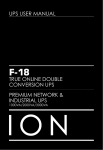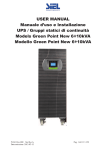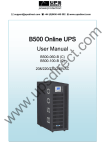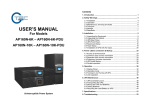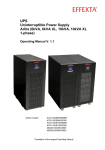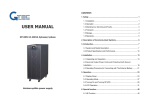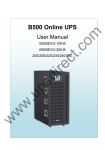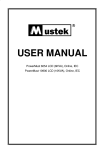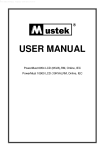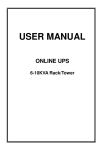Download USER MANUAL - Agenda
Transcript
USER MANUAL ON LINE UPS 6K– 10KVA Uninterruptible Power Supply IP-9306-10 10. Software CONTENTS Free Software Download – WinPower 1.Safety lnstructions…………………………………………………………………1-3 WinPower is a UPS monitoring software, which provides user-friendly interface to monitor and control UPS. This unique software provides safely auto shutdown for multi-computer systems while power failure. With this software, users can monitor and 2.Description of Commonly Used Notations…………………………………….4 control any UPS on the same LAN, which communicated with local computer through RS232 or USB protocol, no matter how far from the UPSs. 3.Introduction 6K/10K………………………………………………………………..5-11 4.Rear View………………………………………………………………11 5.Operation……………………………………………………………………………12-33 6.Special Function…………………………………………………………………...34-39 7.Trouble Shooting…………………………………………………………………..40-43 8.Battery Maintenance………………………………………………………………44 9.Communication Port………………………………………………………………45-46 Installation procedure: 1. Go to the website: http://www.ups-software-download.com/ 2. Choose the operation system you need and follow the instruction described on the website to download the software. 3. When downloading all required files from the internet, enter the serial No: 511C1-01220-0100-478DF2A to install the software.When the computer restarts, the WinPower software will appear as a green plug icon located in the system tray, near the clock. -47- 10.Software……………………………………………………………………………47 1. Safety Instructions RS-232 communication port pin assignments Please read the FOLLOWING user manual and the safety instructions before installing the unit and starting it up! Pin 1.1 Transport Signal name 1 ★Please transport the UPS system only in the original packaging (to protect against shock and impact). 1.2 Set-up ★Condensation may occur if the UPS system is moved directly from a cold to a warm environment. The UPS system must be absolutely dry before being installed. Please allow an acclimatization time of at least two hours. ★Do not install the UPS system near water or in damp environments. Direction from Function the UPS Unused Not applicable Out 2 Tx Transmit to external device 3 Rx Receive from external In device 4 Unused Not applicable Signal common Not applicable 6 Unused Not applicable 5 GND 7 Unused Not applicable ★Do not install the UPS system where it would be exposed to direct sunlight or near 8 Unused Not applicable heat. 9 Unused Not applicable ★ Do not block off ventilation openings in the UPS system’s housing. 9.4 Intelligent slot 1.3 Installation ★Do not connect appliances or items of equipment which would overload the UPS system (e.g. laser printers) to the UPS outlet socket ★Place cables in such a way that no one can step on or trip over them. This series is equipped with an intelligent slot for other optional card to achieve remote management of the UPS through internet / intranet. Please contact your local distributor for further information. ★Do not connect domestic appliances such as hair dryers to UPS output sockets. ★The UPS can be operated by any individuals with no previous experience -1- - 46 - ◇Installation for 6K/ 10K 9. Communication Port ★Warning: This is a product for restricted sales distribution to informed partners. 9.1 USB Interface Installation restrictions or additional measures may be needed to prevent The USB port is compliance with USB 1.1 protocol for its communication software. disturbances’. 9.2 Dry contact Interface ★A readily accessible disconnect device shall be incorporated in the building installation This series UPS has independent dry contact interface. Please contact your local distributor for details. The following is the pin assignment and description of DB-9 connector. wiring and must be close to the UPS system. ★This is permanently connected equipment and only qualified maintenance personnel may carry out installations. Pin # Description I/O Pin # Description I/O 1 UPS Fail Output 6 Bypass Output 2 Summary Alarm Output 7 Battery Low Output 3 GND Input 8 UPS ON Output 4 Remote Shutdown Input 9 Line Loss Output 5 Common Input 1.4 Operation ★Do not disconnect the mains cable on the UPS system or the building wiring socket outlet (shockproof socket outlet) during operations since this would cancel the protective earthing of the UPS system and of all connected loads. ★The UPS system features its own, internal current source (batteries). The UPS output sockets or output terminals block may be electrically lived even if the UPS system is not connected to the building wiring socket outlet. ★In order to fully disconnect the UPS system, first press the Standby switch then disconnect the mains lead ★ Ensure that no fluids or other foreign objects can enter the UPS system. 9.3 RS-232 Interface( (optional) ) ★ The UPS operates with hazardous voltages. Only qualified maintenance personnel may carry The RS-232 port is available for UPS monitoring, control, and firmware updates. The cable pins for the RS-232 communication port are identified in the following illustration. -45- -2- 1.5 Maintenance, servicing and faults ★ by qualified maintenance personnel. ★ 8. Battery Maintenance The UPS system operates with hazardous voltages. Repairs may be carried out only Battery replacement should be performed by qualified personnel. Caution - risk of electric shock. Even after the unit is disconnected from the mains power supply (building wiring socket outlet), components inside the UPS system are standard models are value regulated sealed lead-acid maintenance free still connected to the battery and are still electrically live and dangerous. ★ ★ This series UPS only requires minimal maintenance. The battery used for battery. These models require minimal repairs. The only requirement is to Before carrying out any kind of servicing and/or maintenance, disconnect the batteries and verify that no current is present and no hazardous voltage exist in the charge the UPS regularly in order to maximize the expected life of the battery. terminals of high capability capacitor such as BUS-capacitors. When being connected to the mains power, whether the UPS is turned on or Only persons are adequately familiar with batteries and with the required not, the UPS keeps charging the batteries and also offers the protective precautionary measures may replace batteries and supervise operations. function of overcharging and over-discharging. Unauthorised persons must be kept well away from the batteries. ★ Caution - risk of electric shock. The battery circuit is not isolated from the input for a long time. voltage. Hazardous voltages may occur between the battery terminals and the ground. Before touching, please verify that no voltage is present! ★ with batteries: In the regions of hot climates, the battery should be charged and discharged every 2 months. The standard charging time should be at least 12 hours. Batteries may cause electric shock and have a high short-circuit current. Please take the precautionary measures specified below and any other measures necessary when working The UPS should be charged once every 4 to 6 months if it has not been used Under normal conditions, the battery life lasts 3 to 5 years. In case if the battery is found not in good condition, earlier replacement should be made. - remove wristwatches, rings and other metal objects - use only tools with insulated grips and handles. Replace batteries with the same number and same type of batteries. ★ When changing batteries, install the same number and same type of batteries. Do not replace the battery individually. All the batteries should be replaced at ★ Do not attempt to dispose of batteries by burning them. This could cause battery explosion. ★ Do not open or destroy batteries. Escaping electrolyte can cause injury to the skin and eyes. It may be toxic. ★ the same time following the instructions of the battery supplier. If the battery service life (3~5 years at 25°C ambi ent temperature) has been exceeded, the batteries must be replaced. Please replace the fuse only by a fuse of the same type and of the same amperage in order to avoid fire hazards. ★ Do not dismantle the UPS system. -3- - 44 - 2. Description of commonly used notations 7.3 Trouble Shooting In Else Cases Problem Possible cause Remedy No indication, no warning No input voltage Check the building wiring and input your application process. Therefore, all users should be familiar with them and tone even though system cable. understand their explanations. is connected to mains Check if the input breaker is power supply closed. BYPASS LED light up even Inverter not switched on Some or all of the following Notations may be used in this manual and may appear in Press On-Switch “I” to turn on though the power supply is UPS. available BATTERY LED lights up, Input voltage and/or Check input power source. and audible alarm frequency are out of Check the building wiring and input sounding every 1 beep in tolerance cable. every 4 seconds Check if the input breaker is closed. Emergency supply period Batteries not fully Charge the batteries for at least 12 shorter than nominal value charged / batteries hours and then check capacity. defect Please have the following information at hand before calling the After-Sales Service Department: 1. Model number, serial number 2. Date on which the problem occurred 3. LCD/LED display information, Buzzer alarm status 4. Mains power condition, load type and capacity, environment temperature, ventilation condition 5. The information (battery capacity, quantity) of external battery pack if the UPS is “S” model 6. Other information for complete description of the problem - 43 - -4- 7.2 Trouble Shooting According To Fault Indication 3. Introduction – 6K/10K 3.1 Product Specification and Performance Problem Displayed Possible cause Remedy Inv Overload Fault Overload Check the loads and remove some non-critical loads. 1) General Specification Model No. Phase Voltage Frequency Current(A)* THDI Power Factor Check if some loads are failed. INPUT 6K(E) 10K(E) Single 176~276VAC (45~55)/(54~66) Hz 25.8 Byp Overload Fault Check the loads and remove some non-critical loads. Overload Check if some loads are failed. Output Short Circuit Remove all the loads. Turn off the UPS. Output short circuit 43.0 < 5% @ full load Check if UPS output and loads is short circuit. ≥0.99 @ full load *Rated current while input rated voltage is 230VAC OUTPUT Model No. 6K(E) 10K(E) Power rating 6kVA/5.4kW 10kVA/9kW 208*/220/230/240×(1 士 1%)VAC Voltage 50/60×(1±0.05)Hz (Battery mode) Frequency Wave form Sinusoidal Load type PF 0.5 1, lagging < 2% @ full linear load THDV <5% @ full non linear load In Line mode**: 10 min 105~125% 1 min 125~150% 10 s >150% Overload 100 ms >170% In Battery mode: 2 min 105~125% 30 s 125~150% 100 ms >150% Ensure short circuit is removed before turning on again. Heatsink Over Temperature Fault Inside temperature of UPS is too high Check the ventilation of UPS and the ambient temperature. Bus Over Voltage UPS internal fault Consult dealer. Bus Under Voltage UPS internal fault Consult dealer. Bus Unbalance UPS internal fault Consult dealer. Bus short UPS internal fault Consult dealer. Bus Softstart Fail UPS internal fault Consult dealer. Inv Over Voltage UPS internal fault Consult dealer. Inv Under Voltage UPS internal fault Consult dealer. Inv Softstart Fail UPS internal fault Consult dealer. Negative Power Fault The load is pure inductive and capacitive Remove some non-critical loads. Cable male and female Loss fault The parallel cable is disconnected Check the parallel cable. Fan lock fault Fan blocked or Check the fan status *The load capacity would be derated to 90% automatically when the output voltage is adjusted to 208VAC. **The overload capacity would be derated automatically in Line mode while the circumstance temperature is larger than 35 degree. Bypass supplies the load first, ensure there is no overload, then turn on UPS. disconnected over time Back Feed Output voltage is returned to input -5- -42- Consult dealer 2) Operating Environment Over Charge Battery is over charged The UPS will turn off the charger until the battery voltage is normal Consult dealer. Model Pin Error UPS internal fault Ambient Over Temperature The ambient temperature is too high Inside temperature of UPS is too high UPS internal fault Check the environment ventilation. Para Cable Male Loss The parallel cable is disconnected Check the parallel cable. Para Cable Female Loss The parallel cable is disconnected The battery packs of some UPSs are disconnected Check the parallel cable. The mains input of some UPSs is disconnected Check the building wiring and input cable. Check if the input breaker is closed. Ensure the UPSs are connected to same input source. Heatsink Over Temperature Ambient NTC abnormal Para Bat Differ Para Line Differ Para Work Mode Differ Check if all the battery pack is connected. ECO In Para HE function is enabled in parallel system The UPSs with different power strategy setting (Ex. one Line mode and one Converter mode) are forbidden to parallel. The UPSs with different capacity (Ex. one 6KVA and one 10KVA) are forbidden to parallel. HE function is forbidden in parallel system. IP Fuse Open Input fuse break Check the input fuse status Para Rate Power Differ There are different power strategy setting in parallel system Check the ventilation of UPS and the ambient temperature. Consult dealer. There are different UPSs in parallel system o o Operating Temperature 0 C to 45 C Operating humidity < 95% Altitude < 1000m* Storage temperature -15 C to 50 C o o *The load capacity should be derated 1% every 100m heightened on the basis of 1000m. 3.2 Typical Backup Time (Typical values at 25°C in minutes) Model No. 100 % Load 6K 5 10K 4 3.3 Unpacking and Inspection 1) Unpack the packaging and check the package contents. The shipping package contains: A UPS A user manual A communication cable A battery cable (for 6KE/10KE only) 2) Inspect the appearance of the UPS to see if there is any damage during transportation. Do not turn on the unit and notify the carrier and dealer immediately if there is any damage or lacking of some parts. - 41 - -6- 3.4 Input and output power cords and protective earth ground installation 7. Trouble Shooting If the UPS system does not operate correctly, first check the operating information on the 1. Notes for installation LCD display. 1) The UPS must be installed in a location with good ventilation, far away from water, inflammable gas and corrosive agents. Please attempt to solve the problem using the table below. If the problem still persists, consult your dealer. 2) Ensure the air vents on the front and rear of the UPS are not blocked. Allow at 7.1 Trouble Shooting According To Warning Indication least 0.5m of space on each side. 3) Condensation to water drops may occur if the UPS is unpacked in a very low temperature environment. In this case it is necessary to wait until the UPS is Problem Displayed UPS internal fault EPO connector is open Consult dealer. Check the EPO connector status On Maintain Bypass Maintain bypass switch is open Check the maintain bypass switch status IP soft-start failed UPS internal fault Consult dealer Site Wiring Fault Phase and neutral conductor at input of UPS system are reversed Reverse mains power wiring. Battery Disconnect Battery pack is not connected correctly Do the battery test to confirm. Check the battery bank is connected to the UPS. Check the battery breaker is turn on. Battery low Battery voltage is low Output Overload Overload When audible alarm sounding every second, battery is almost empty. Check the loads and remove some non-critical loads. Check if some loads are failed. other insulated wire which complies with AWG Standard for the UPS input and Fan Failure Charger Fail Fan abnormal The charge fails Check if the fan is running normally. Consult dealer. output wirings Battery Over Voltage Battery voltage is higher than normal value Check if the battery quantity is right. are hazards of electric shock. 2. Installation Installation and wiring must be performed in accordance with the local electric code and the following instructions by professional personnel. For safety, please cut off the mains power switch before installation. The battery breaker also needs to be cut off if it is a long backup time model (“E” model). Open the terminal block cover located on the rear panel of the UPS, please refer to the appearance diagram. ii. 2 For 6K(E) UPS, it is recommended to select the UL1015 10AWG(6mm ) wire or other insulated wire which complies with AWG Standard for the UPS input and output wirings. iii. Remedy Read EEPROM Error EPO Active fully dried inside out before proceeding installation and use. Otherwise there i. Possible cause 2 For 10K(E), it is recommended to select the UL1015 8AWG(10mm ) wire or -7- -40- 3) 4) 5) 6) automatically, set the own maintenance switch of each UPS from “UPS” to “BPS”. Set the main maintenance switch or static switch from “UPS” to “BPS”, switch off the main output breaker and the main input breaker, and the UPSs would shut down. Ensure the UPSs shut down totally, remove the wanted UPS and reinstall the new UPS parallel system by following step 1) to 9) of last chapter - “install a new parallel UPS system”. If the removed UPS or the remained UPS will be used in a stand-alone mode, then JP1 and JP2 on the terminal block should be connected with a short connection wire. Switch on the main input breaker and the main output breaker, and set the main maintenance switch or static switch from “BPS” to “UPS”, then set the UPS own maintenance switch from “BPS” to “UPS” and screw the maintenance cover plate back again. Press the button of one UPS, each UPS would start to turn on, after turning on, the UPSs should work parallel in the Line mode. Note: Do not use the wall receptacle as the input power source for the UPS, as its rated current is less than the UPS’s maximum input current. Otherwise the receptacle may be burned and destroyed. 4) Connect the input and output wires to the corresponding input and output terminals according to the following diagram. Note: you must make sure that the input and output wires and the input and output terminals are connected tightly. 5) The protective earth ground wire refers to the wire connection between the equipment which consumes electric equipment and the ground wire. The wire diameter of protective earth ground wire should be at least as above mentioned for each model and green wire or green wire with yellow ribbon wire is used. 6) After having completed the installation, make sure the wiring is correct. 7) Please install the leak current protective breaker at the output power distribution panel of the UPS if necessary. 9) To connect the load with the UPS, please turn off all the loads first, then perform the connection and finally turn on the loads one by one. 7. Trouble Shooting 10) No matter the UPS is connected to the utility power or not, the output of the UPS If the UPS system does not operate correctly, first check the operating may have electricity. The parts inside the unit may still have hazardous voltage after information on the LCD display. turning off the UPS. To make the UPS have no output, power off the UPS, and then disconnect the utility power supply. 10 ) Please attempt to solve the problem using the table below. If the problem still persists, consult your dealer. Suggest charging the batteries for 8 hours before use. After connection, turn the input breaker in the “ON” position, the UPS will charge the batteries automatically. You can also use the UPS immediately without charging the batteries first, but the backup time may be less than the standard value. - 39 - -8- 11) If it is necessary to connect the inductance load such as a monitor or a laser printer to the UPS, the start-up power should be used for calculating the capacity of the UPS, as its start-up power consumption is too big when it is started. Input and output Terminal Block wiring diagram of 6K(E)/10K(E) Important notes: If the UPS is used in single mode, JPI and JP2 must be connected by 10AWG(6mm2). If the UPS is used in parallel mode, the Jumper between JP1 and JP2 must be removed. 3.5 Operating procedure for connecting the long backup time model UPS with the external battery 1. The nominal DC voltage of external battery pack is 240VDC. Each battery pack consists of 20 pieces of 12V maintenance free batteries in series. To achieve longer backup time, it is possible to connect multi-battery packs, but the principle of “same voltage, same type” should be strictly followed. 2. The connector of the external battery cable is used to plug into the external battery socket of the UPS, the other end of the external battery cable is made of three open wires with ring terminals to connect with the external battery pack(s). The procedure of installing battery bank should be complied with strictly. Otherwise you may encounter the hazardous of electric shock. -9- 11 )Press the button of one UPS, each UPS would start to turn on, after turning on, the UPSs should work parallel in the Line mode. How to join a new UPS to a parallel system: 1) First the parallel system must be installed one main maintenance mechanical switch or static switch. 2) Regulate the output voltage of the new UPS separately: check if the output voltage difference between the new UPS and the parallel system is less than 0.5V. 3) Ensure the bypass of the parallel system is normal and the bypass setting is “enable”, remove the cover plate of maintenance switch on the rear panel of each UPS, the UPS system would transfer to bypass automatically, set the own maintenance switch of each UPS from “UPS” to “BPS”. 4) Set the main maintenance switch or static switch from “UPS” to “BPS”, switch off the main output breaker and the main input breaker, the UPSs would shut down. 5) Ensure the UPSs shut down totally, add the new UPS and reinstall the new UPS parallel system by following step 1) to 9) of last chapter - “install a new parallel UPS system”. 6) Switch on the main input breaker and the main output breaker, and set the main maintenance switch or static switch from “BPS” to “UPS”, then set the UPS own maintenance switch from “BPS” to “UPS” and screw the maintenance cover plate back again. Press the button of one UPS, each UPS would start to turn on, after turning on, the UPSs should work parallel in the Line mode. How to remove a single UPS from a parallel system: 1) First the parallel system must be installed one main maintenance mechanical switch or static switch. 2) Ensure the bypass is normal and the bypass setting is “enable”, remove the cover plate of maintenance switch on the rear panel of each UPS, the UPS system would transfer to bypass -38- 1) A DC breaker must be connected between the battery pack and the UPS. The capacity of breaker must be not less than the data specified in the general specification. 2)Set the battery pack breaker in “OFF” position and connect the 20 pieces of batteries in series. 3)You must connect the external battery cable to the battery first, if you connect the cable to the UPS first, you may encounter the hazardous of electric shock. The positive pole of the battery is connected to the 10KE in parallel with blue and brown wires; the negative pole of the battery is connected to the 10KE in parallel with black and white wires; the green and yellow ribbon wire is connected to the ground of the battery cabinet. 2. To complete the connection by plugging the connector of the external battery cable into the external battery socket of the UPS. Do not attempt to connect any loads to the UPS now. You should connect the input power wire to the right position Parallel System Installation Diagram first. And then set the breaker of the battery pack in the ON position. After that set the input breaker in the ON position. The UPS begins to charge the battery packs at 10) Do not switch on the output breaker of each UPS, switch on the input breaker of the time. the each UPS, the UPS should work in bypass with output, observe their display to check if there are any warning or fault information, measure the output voltage of each UPS separately to check if the voltage difference between them is less than 1V. If the difference is more than 1V, check the wiring. 11) Press the button of one UPS, each UPS would start to turn on, all the UPSs 3.6 EPO Connection 3.6.1 Introduction Emergency power off function which the UPS supplies is, when the emergency would transfer to the INV mode together. Measure the output voltage of each UPS occurs, such as the failure of load, the UPS can cut off the output at once by separately to check if the voltage difference between them is less than 0.5V. If the operating the EPO port manually. difference is more than 0.5V, the UPSs need to be regulated. 12) Press the button of one UPS, each UPS would start to turn off and transfer to the Bypass mode, switch on the output breaker of each UPS to parallel all the output of UPSs together 3.6.2 The connection Normally the EPO connector is closed with a wire on the rear panel, which is supplied in the accessory. Once the connector is open, the UPS would stop the output and enter EPO status. -37- - 10 - 6.3.2 Parallel installation and operation How to install a new parallel UPS system: Enable the EPO status 1 ) Before installing a new parallel UPS system, user need to prepare the input and output wires, the output breaker, and the parallel cable. LCD menu (illustrated in the chapter of 5.4.5) to clear EPO status, then UPS 2 ) Users need to use a standard 25-pin communication cable, which should have 25 cores, corresponding stitches and shield, as the UPS parallel cable. The length of the parallel cable is appropriate to be less than 3m. Disable the EPO status Fig. 4-8 Default EPO status To recover to normal status, first EPO connector should be closed, and enter would stop alarm and recover to Bypass model. And UPS needs be turned on by manual operation. The polarity of connector could be inversed by setting in LCD menu in the chapter of 5.4.7. Contact your local distributor for further information before modifying the settings. 3) Remove the cover plate of the parallel port on the UPS, connect each UPS one by one with the parallel cable, and re-screw the Parallel port cover which is supplied in the accessories. 4) Strictly follow the chapter of 4, the wiring requirement of single UPS to perform the wiring of each UPS. 4. Rear View 5) Connect the output wires of each UPS to an output breaker panel. 6) Disconnect the Jumper on JP1 and JP2 of the terminal block first, and connect each output breaker to a main output breaker and then to the loads. 7) Each UPS need an independent battery pack. 8) Please refer to the wiring diagram in the following diagram. 9) The distance between the UPSs in parallel and the breaker panel is required to be less than 20 meters. The difference between the wires of input and output of the UPSs is required to be less than 20%. - 11 - -36- 5. Operation 6.2 Converter Function 6.2.1 Brief introduction of Converter function In converter mode, the UPS would free run with fixed output frequency (50Hz or 60Hz). Once the mains power is loss or abnormal, the UPS would transfer to Battery mode and the load is supplied continuously. The great virtue is the output frequency is fixed, which is required by some very sensitive loads. But the disadvantage is the load capacity of UPS should be derated to 60% in converter mode. 5.1 Display Panel The UPS has a four-button dot matrix LCD with dual color backlight. Standard back-light is used to light up the display with white text and a blue background. When the UPS has a critical alarm, the backlight changes the text to dark amber and the background to amber. Besides the LCD, the UPS has four colorized LEDs to provide more convenient information. 6.2.2 Set the function The function could be enabled through the LCD setting in Bypass mode. Enter the power strategy setting menu by following chapter of 5.4.7. 6.3 Parallel Function 6.3.1 Brief introduction of the redundancy N+X is currently the most reliable power supply structure. N represents the minimum UPS number that the total load needs, X represents the redundant UPS number, i.e. the fault UPS number that the system can handle simultaneously. When the X is larger, the reliability of the power system is higher. For occasions where reliability is highly depended on, N+X is the optimal mode. As long as the UPS is equipped with parallel cables, up to 4 UPSs can be connected in parallel to realize output power sharing and power redundancy. - 35 - Fig. 5-1 Control Panel Table 5-1 Control Button Functions The Button Function Power on Turn on Turn off Illustration When the unit is no power and has connected with battery, press this button for >100ms&<1s to power on When the unit is powered on and is in Bypass mode, press this button for >1s to turn on When the unit has been turned on, press this button for >3s to turn off - 12 - Enter main menu Exit main menu Scroll up Scroll down Enter next menu tree Select one menu option Confirm the present setting When displaying default UPS status summary screen, press this button for >1s to enter the main menu tree Press this button for >1s to exit the present menu to default system status display menu without executing a command or changing a setting Press this button for >100ms&<1s to scroll up the menu option Press this button for >100ms&<1s to scroll down the menu option Press this button for >100ms&<1s to select the present menu option, or enter next menu, but do not change any setting Press this button for >100ms&<1s to select the present menu option, or enter next menu, but do not change any setting Press this button for >1s to confirm the edited options and change the setting Table 5-2 LED definition UPS state Normal LED (Green) Bypass mode with no output Bypass mode with output Turning on Line mode Battery mode HE mode Battery test mode Fault mode Warning mode △ Battery LED (Yellow) △ Bypass LED (Yellow) (Red) ★ ↑ ● ↑ △ △ ↑ 6.1 HE Function 6.1.1 Brief introduction of HE function If HE function is set to enable, after the UPS is turned on, the power used by the load is directly supplied from the mains power via internal filter while the utility power is in normal range, so the high efficiency could be gained in HE mode. It is also called economy mode. Once the mains power is loss or abnormal, the UPS would transfer to Line mode or Battery mode and the load is supplied continuously. The great virtue is overall high efficiency ≥ 0.96 of UPS, to save power for user. But the disadvantage is 1) the load can not be protected as well as in Line mode, for the load is directly supplied from the mains; 2) the transfer time of UPS output from HE mode to Battery mode is about 10ms. So the function is not suitable to some sensitive loads, and the region where the mains power is unstable. ↑ 6.1.2 Set the function ● ↑ △ △ The function could be enabled through the LCD setting in Bypass mode. Enter the power strategy setting menu by following chapter of 5.4.7. ↑ ● ↑ ★ ● ● △ The series UPS has some special functions, which could satisfy some special application of user. And the functions have own features, please contact your local distributor for further information before using the function. ↑ ● ● Fault LED 6. Special Function △ ↑ - 13 - 34 - Note: : Example: set rated output voltage value ●: Lightened constantly △: #1-#4 Lightened circularly ★: Flashing ↑: Depended on the fault/warning status or other status Table 5-3 Alarm definition UPS condition Buzzer status Fault active Warning active Continuous Beep every second Beep every 4 seconds, if battery low, buzzer Beep every second Beep every 2 minutes Beep twice every second Ba tery output Bypass output Overload Fig. 5-22 Set rated output voltage value - 33 - The UPS provides useful information about UPS itself, load status, events, measurements, identification, and settings through the front panel display. During powering on, the LCD would display the Welcome logo for several seconds and then enter to the default page which shows the UPS status summary. The display automatically returns to the default UPS status summary screen when no button has been pressed for 15 minutes. On the UPS status summary screen it provides the following information: Status summary, including mode and load Alarm status, if any are present Notes: alarm including fault and warning information Battery and charger status, including battery voltage, charge level and charger status Running information including parallel UPS and running time - 14 - UPS operating status Table 5-4 Battery information Input Output 220 V 273.0 V 60 Hz 220 V UPS output information 60 Hz 100% 5400 W Utility input information Load information Fig. 5-2 The default LCD display The more detailed operation of LCD is illustrated in the chapter of 5.4. 5.2 Operating Mode The different graphic symbol could be displayed corresponding to current operating mode or status. 5.2.1 Line mode The example of LCD display in Line mode is shown in the following diagram. Submenu item Optional Values Default value User password enabled/disabled disabled Audio alarm enabled/disabled enabled Rated output voltage 208/220/230/240V 230V Output frequency autosensing/50/60Hz autosensing Power strategy** normal/high efficiency/ converter normal DC start enabled/disabled enabled Site wiring fault alarm Ambient temperature warning Automatic battery tests period Auto Restart enabled/disabled enabled enabled/disabled enabled 0-31days 7days enabled/disabled enabled Automatic overload restart enabled/disabled enabled AutoBypass enabled/disabled enabled Short circuit clearance enabled/disabled disabled Bypass voltage low limit 110~215V 176V Bypass voltage high limit 245~276V 264V Bypass frequency low limit 1%~10% 10% Bypass frequency high limit 1%~10% 10% HE voltage low limit 1%~10% 5% HE voltage high limit 1%~10% 5% HE frequency low limit 1%~10% 5% HE frequency high limit 1%~10% 5% Battery quantity*** 19/20/21 Day:hour:minute:second 0000:0000:00~9999:23:59:59 -5~+5 20 Set running time LCD contrast Fig. 5-3 Line mode 0 *Password is AAAA when enabled. **Read the chapter of 6.1 and 6.2, before using high efficiency or converter function. ***Ensure the real battery quantity is same as the setting, or the batteries would be damaged permanently. -32 - 15 - Running time 5.2.2 Battery mode The example of LCD display in battery mode is shown in the following diagram. Fig. 5-4 Battery mode When the UPS is running in battery mode, the buzzer beeps once every 4 seconds. 5.2.3 Bypass with output The LCD display in bypass mode with output is shown in the following diagram. The UPS does not have the backup function when it is in bypass mode. The power used by the load is supplied from the mains power via internal filter. The UPS will beep once every 2 minutes in bypass mode. Fig. 5-21 Setting menu tree By press on the menu of “Identification”, the display would enter the next setting menu tree if “User password” is disabled. If “User password” is enabled, the user should enter the password by press , , and , then enter the next setting menu tree. -31- Fig. 5-5 Bypass mode with output -16- 5.2.4 Bypass without output The LCD display in bypass mode without output is shown in the following diagram. Fig. 5-6 Bypass mode without output 5.2.5 HE mode (High Efficiency mode) It is also called economy mode. After the UPS is turned on, the power used by the load is supplied from the mains power via internal filter while the mains power is in normal range, so the high efficiency could be gained in the HE mode. Once the mains power is loss or abnormal, the UPS would transfer to Line mode or Battery mode and the load is supplied continuously. Fig. 5-20 Identification menu tree 5.4.7 The setting menu Please contact your local distributor for further information before using the settings. Some settings would change the specification, and some settings would enable or disable some functions. The unsuitable option set by user may result in potential failures or protecting function loss, even directly damage the load, battery or UPS. The most of settings could only be done while UPS is in Bypass mode. Fig. 5-7 HE mode 1) The function could be enabled through the LCD setting or the software (Winpower, etc.). -17- -30- Example: clear EPO status Clear EPO status By press 2) <1s Status:EPO active Clear:no By press or <1s Status:EPO active Clear:yes By press >1s It is attention that the transfer time of UPS output from HE mode to battery mode is about 10ms. But it is still too long for some sensitive load. 5.2.6 Converter mode In converter mode, the UPS would free run with fixed output frequency (50Hz or 60Hz). Once the mains power is loss or abnormal, the UPS would transfer to battery mode and the load is supplied continuously. Status:EPO inactive Clear:no Note: First make sure the EPO signal is inactive or the LCD will show below information and the EPO active status couldn’t be cleared. Fig. 5-8 Converter mode Fig. 5-19 clear EPO status 1) 2) The function could be enabled through the LCD setting or the software (Winpower, etc.). The load should be derated to 60% in converter mode. 5.4.6 The identification menu 5.2.7 Warning By press on the menu of “Identification”, the display would enter the next identification menu tree. The identification information includes UPS serial number, firmware serial number, model type, would be shown here. By press >1s, the display would return the last main menu tree. When the warning occurs, it illustrates that there are some abnormal problems during the operation of UPS. Normally the problems are not fatal and the UPS continues working, but they should be paid attention to, or the UPS may fail. The detailed warning table is shown in chapter of 7. -29- -18- Fig. 5-9 Warning 5.2.8 Fault When the fault occurs, it illustrates that some fatal problems happened, the UPS would directly cut off the output or transfer to bypass, and keep alarming. The backlight of LCD would also turn to red. The detailed fault table is shown in chapter of 7. Fig. 5-10 Fault 5.2.9 Other status When the UPS is overload, the alarm will beep twice every second. Some unnecessary loads should be get rid of one by one to decrease the loads connected to the UPS less than 90% of its nominal power capacity. -19- Fig. 5-18 Control menu tree -28- 5.4.5 The control menu By pressing on the menu of “Control”, the display would enter the next control menu tree. 1) Single UPS turn off: is one command to turn off one UPS which is operated currently in a parallel system, and other UPSs continue working to supply the load in the parallel system. 2) Single UPS battery test: is one command to control one UPS which is operated currently in a parallel system to do the battery test singly, and other UPSs do not do the battery test. 3) Parallel UPS battery test: is one command to control all UPS in a parallel system to do the battery test at the same time. 4) Clear EPO status: once EPO status is enabled, the UPS output would be cut off. To recover to normal status, first EPO connector should be closed, and enter this menu to clear EPO status, then UPS would stop alarm and recover to Bypass model. And UPS needs be turned on by manual operation. 5) Reset fault status: when fault occurs, UPS would keep in Fault mode and alarm. To recover to normal status, enter this menu to reset error status, then UPS would stop alarm and recover to Bypass mode. And the reason of fault should be checked and deleted before UPS is turned on again by manual operation. 6) Restore factory settings: all the settings would be recover to default factory settings. It could only be done in Bypass mode Fig. 5-11 Overload While doing the battery test, LEDs would be lighted circularly, and the symbol of battery test would be shown on the display. Fig. 5-12 Battery test And if the battery status detected is “battery disconnected”, the symbol of battery failure would be shown and UPS would alarm. Fig. 5-13 Battery fails -27- -20- 5.3 Turning On and Turning Off UPS Attention: The UPS could only be turning on while connecting with the mains at the first time. Attention: Please switch off the connected loads first before turning on the UPS, and switch on the loads one by one after the UPS is turned on. Switch off all of the connected loads before turning off the UPS. 5.3.1 Turning on UPS with mains 1) Check all the connection is correct. Check the breaker of external battery pack is in “ON” position. 2) Set input breaker in “ON” position. At this time the fan begins to rotate, LCD will show “WELCOME”. Then LCD will show the default UPS status summary screen after UPS finishing self-test. 3) By pressing button continuously for more than 1 second, the buzzer will beep for 1s, UPS starts to turn on. 4) A few seconds later, the UPS turns into Line mode. If the mains power is abnormal, the UPS will transfer to Battery mode without output interruption of the UPS. 5.4.4 The measurement menu By pressing on the menu of “Measurement”, the display would enter the next measurement menu tree. A lot of detailed useful information could be checked here, Ex. the output voltage and frequency, the output current, the load capacity, the input voltage and frequency, etc. By pressing >1s, the display would return the last main menu tree. 5.3.2 Turning on UPS without mains 1) Check all the connection is correct. Check the breaker of external battery pack is in “ON” position. 2) By pressing button continuously for more than 100ms, the UPS would be powered on. At this time the fan begins to rotate, LCD will show “WELCOME”. Then LCD will show the default UPS status summary screen after UPS finishing self-test. 3) By pressing button continuously for more than 1s, the buzzer will beep for 1s, UPS starts to turn on. 4) A few seconds later, the UPS turns into Battery mode. If the mains power comes back, the UPS will transfer to Line mode without output interruption of the UPS. -21- Fig. 5-17 Measurement menu tree -26- 5.4.3 The event log menu 5.3.3 Turning off UPS with mains By pressing on the menu of “Event log”, the display would enter the next event menu tree. All the old event, alarm and fault have been recorded here. The information includes the illustration, the event code, and the operating time of UPS when the event happened. By press or <1s, all the event could be displayed one by one. The max number of record is 50, when the number is larger than 50, the oldest one would be changed to the newest information. By pressing >1s, the display would return the last main menu tree. 1) 2) To turn off the inverter of UPS by pressing button continuously for more than 3s and the buzzer will beep for 3s. The UPS will turn into Bypass mode at once. When completing the above action, UPS output voltage is still present. In order to cut off the UPS output, simply cut off the mains power supply. A few seconds later, LCD display shuts down and no output voltage is available from the UPS output terminal. 5.3.4 Turning off UPS without mains 1) 2) To power off the UPS by pressing button continuously for more than 3s, and the buzzer will beep 3s. The UPS will cut off the output at once. A few seconds later, LCD shuts down and no voltage is available from the UPS output. 5.4 LCD Operation Except the default UPS status summary screen, the user could get more useful information about UPS current status, detailed various measurements, old events which ever occurred, UPS own identification, and could change the settings to fit the user own requirements, optimize the function of UPS. 5.4.1 The main menu In the default UPS status summary screen, when pressing or <1s, the detailed information about alarm, the parallel system, battery would be shown. In the default UPS status summary screen, when pressing >1s, the display would enter main menu tree. The main menu tree includes six branches: UPS status menu, event log menu, measurement menu, control menu, identification menu, setting menu. Fig. 5-16 Event menu tree -25- -22- 5.4.2 The UPS status menu W ELCO M E By pressing on the menu of “UPS status”, the display would enter the next UPS status menu tree. The content of UPS status menu tree is same as the default UPS status summary menu. U P S status By pressing >1s, the display would return the last main menu tree. A l a rm # 4 1 E ve nt log B a tte r y V o l t: 2 2 0 V B a tte r y c h a r g in g C h a r g e r l e v e l :1 0 0 % M ea sure m e nts S tatu s: In c re a s e m o d e P a ra N u m : 2 R u n n i n g t im e : 0 0 0 1 : 0 3 : 0 1: 0 0 C o n tr o l I d e n ti fi c a t i o n S e t t in g s Fig. 5-15 UPS status menu tree ig. 5-14 Main menu tree -23- -24-


























